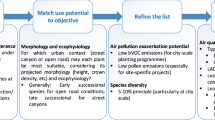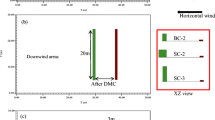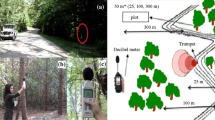Abstract
Roadside vegetation has been shown to impact downwind, near-road air quality, with some studies identifying reductions in air pollution concentrations and others indicating increases in pollutant levels when vegetation is present. These widely contradictory results have resulted in confusion regarding the capability of vegetative barriers to mitigate near-road air pollution, which numerous studies have associated with significant adverse human health effects. Roadside vegetation studies have investigated the impact of many different types and conditions of vegetation barriers and urban forests, including preserved, existing vegetation stands usually consisting of mixtures of trees and shrubs or plantings of individual trees. A study was conducted along a highway with differing vegetation characteristics to identify if and how the changing characteristics affected downwind air quality. The results indicated that roadside vegetation needed to be of sufficient height, thickness, and coverage to achieve downwind air pollutant reductions. A vegetation stand which was highly porous and contained large gaps within the stand structure had increased downwind pollutant concentrations. These field study results were consistent with other studies that the roadside vegetation could lead to reductions in average, downwind pollutant concentrations by as much as 50% when this vegetation was thick with no gaps or openings. However, the presence of highly porous vegetation with gaps resulted in similar or sometimes higher concentrations than measured in a clearing with no vegetation. The combination of air quality and meteorological measurements indicated that the vegetation affects downwind pollutant concentrations through attenuation of meteorological and vehicle-induced turbulence as air passes through the vegetation, enhanced mixing as portions of the traffic pollution plume are blocked and forced over the vegetation, and through particulate deposition onto leaf and branch surfaces. Computational fluid dynamic modeling highlighted that density of the vegetation barrier affects pollutant levels, with a leaf area density of 3.0 m2 m−3 or higher needed to ensure downwind pollutant reductions for airborne particulate matter. These results show that roadside bushes and trees can be preserved or planted along highways and other localized pollution sources to mitigate air quality and human health impacts near the source if the planting adheres to important characteristics of height, thickness, and density with full coverage from the ground to the top of the canopy. The results also highlight the importance of planting denser vegetation and maintaining the integrity and structure of these vegetation barriers to achieve pollution reductions and not contribute to unintended increases in downwind air pollutant concentrations.






Similar content being viewed by others
References
Abhijith KV, Kumar P, Gallagher J, McNabola A, Baldauf RW, Pilla F, Broderick BM, Di Sabatino S, Pulvirenti B (2017) Air pollution abatement performances of green infrastructure in open road and built-up street canyon environments—a review. Atmos Environ 162:71–86
Al-Dabbous AN, Kumar P (2014) The influence of roadside vegetation barriers on airborne nanoparticles and pedestrians exposure under varying wind conditions. Atmos Environ 90:113–124
Baldauf RW (2017) Roadside vegetation design characteristics that can improve local, near-road air quality. Transp Res Part D: Transp Environ 52:354–361
Baldauf RW, Thoma E, Khlystov A, Isakov V, Bowker GE, Long T, Snow R (2008) Impacts of noise barriers on near-road air quality. Atmos Environ 42(32):7502–7507
Baldauf R, Cahill T, Bailey C, Khlystov A, Zhang KM, Cook R, Bowker G (2009) Can roadway design air quality impacts be used to mitigate from traffic? EM: Air and Waste Management Association’s Magazine for Environmental Managers, Air & Waste Management Association, Pittsburgh, PA, pp 6–11
Baldauf RW, Jackson L, Hagler G, Isakov V, McPherson G, Nowak D, Cahill TA, Zhang K, Cook J, Bailey C, Wood P (2011) The role of vegetation in mitigating air quality impacts from traffic emissions—journal. EM: Air and Waste Management Association’s Magazine For Environmental Managers. Air & Waste Management Association, Pittsburgh, PA, pp 30–33
Baldauf RW, McPherson EG, Wheaton L, Zhang KM, Cahill TA, Bailey C, Fuller CH, Withycombe E, Titus K (2013) Integrating vegetation and green infrastructure into sustainable transportation planning, vol 288. TR News. Transportation Research Board of the National Academies, Washington, DC, pp 14–18
Baldauf RW, Isakov V, Deshmukh PJ, Venkatram A, Yang B, Zhang KM (2016) Influence of solid noise barriers on near-road and on-road air quality. Atmos Environ 129:265–276
Bowker GE, Baldauf RW, Isakov V, Khlystov A, Petersen W (2007) The effects of roadside structures on the transport and dispersion of ultrafine particles from highways. Atmos Environ 41:8128–8139
Brantley HL, Hagler GS, Deshmukh PJ, Baldauf RW (2014) Field assessment of the effects of roadside vegetation on near-road black carbon and particulate matter. Sci Total Environ 468:120–129
Bréda NJ (2003) Ground-based measurements of leaf area index: a review of methods, instruments and current controversies. J Exp Bot 54(392):2403–2417
Brode R, Wesson K, Thurman J (2008) AERMOD sensitivity to the choice of surface characteristics. 101st Annual Conference of the Air & Waste Management Association, Portland, OR
Buccolieri R, Gromke C, Di Sabatino S, Ruck B (2009) Aerodynamic effects of trees on pollutant concentration in street canyons. Sci Total Environ 407:5247–5256
Detto M, Katul GG, Siqueira M, Juang JY, Stoy P (2008) The structure of turbulence near a tall forest edge: the backward-facing step flow analogy revisited. Ecol Appl 18:1420–1435
Frank C, Ruck B (2008) Numerical study of the airflow over forest clearings. Forestry 81:259–277
Gallagher J, Baldauf RW, Fuller CH, Kumar P, Gill LW, McNabola A (2015) Passive methods for improving air quality in the built environment: a review of porous and solid barriers. Atmos Environ 120:61–70
Gramotnev G, Brown R, Ristovski Z, Hitchins J, Morawska L (2003) Determination of average emission factors for vehicles on a busy road. Atmos Environ 37:465–474. https://doi.org/10.1016/S1352-2310(02)00923-8
Gromke C, Buccolieri R, Di Sabatino S, Ruck B (2008) Dispersion study in a street canyon with tree planting by means of wind tunnel and numerical investigations—evaluation of CFD data with experimental data. Atmos Environ 42:8640–8650
Gromke C, Jamarkattel N, Ruck B (2016) Influence of roadside hedgerows on air quality in urban street canyons. Atmos Environ 139:75–86
Hagler GSW, Thoma ED, Baldauf RW (2010) High-resolution mobile monitoring of carbon monoxide and ultrafine particle concentrations in a near-road environment. J Air Waste Manage Assoc 60:328–336
Hagler GSW, Lin MY, Khlystov A, Baldauf RW, Isakov V, Faircloth J, Jackson LE (2012) Field investigation of roadside vegetative and structural barrier impact on near-road ultrafine particle concentrations under a variety of wind conditions. Sci Total Environ 419:7–15
Health Effects Institute (2010) Traffic-related air pollution: a critical review of the literature on emissions, exposure, and health effects. Special Report 17, January, Boston, MA [online]. https://www.healtheffects.org/publication/traffic-related-air-pollution-critical-review-literature-emissionsexposure-and-health. Accessed 28 Nov 2018
Imhof D, Weingartner E, Ordóñez C, Gehrig R, Hill M, Buchmann B, Baltensperger U (2005) Real-world emission factors of fine and ultrafine aerosol particles for different traffic situations in Switzerland. Environ Sci Technol 39:8341–8350. https://doi.org/10.1021/es048925s
Janhäll S (2015) Review on urban vegetation and particle air pollution—deposition and dispersion. Atmos Environ 105:130–137
Jonckheere I, Fleck S, Nackaerts K, Muys B, Coppin P, Weiss M, Baret F (2004) Review of methods for in situ leaf area index determination: part I. Theories, sensors and hemispherical photography. Agric For Meteorol 121(1):19–35
Karner AA, Eisinger DS, Niemeier DA (2010) Near-roadway air quality: synthesizing the findings from real-world data. Environ Sci Technol 44(14):5334–5344
Kimbrough S, Owen RC, Snyder M, Richmond-Bryant J (2017) NO to NO2 conversion rate analysis, and implications for dispersion model chemistry methods using Las Vegas, Nevada near-road field measurements. Atmos Environ 165:23–34. https://doi.org/10.1016/j.atmosenv.2017.06.027
Kimbrough S, Hanley T, Hagler G, Baldauf R, Snyder M, Brantley H (2018) Influential factors affecting black carbon trends at four sites of differing distance from a major highway in Las Vegas. Air Qual Atmos Health 11:181–196. https://doi.org/10.1007/s11869-017-0519-3
Krecl P, Johansson C, Targino AC, Ström J, Burman L, Miguel AH, Kirchstetter TW, Harley RA, Hering SV, Brimblecombe P, Townsend T, Lau CF, Rakowska A, Chan TL, Močnik G, Ning Z (2015) On-road emissions of particulate polycyclic aromatic hydrocarbons and black carbon from gasoline and diesel vehicles. Atmos Environ 32:155–168. https://doi.org/10.1021/es970566w
Lee ES, Ranasinghe DR, Ahangar FE, Amini S, Mara S, Choi W, Paulson S, Zhu Y (2018) Field evaluation of vegetation and noise barriers for mitigation of near-freeway air pollution under variable wind conditions. Atmos Environ 175:92–99
Miguel AH, Kirchstetter TW, Harley RA, Hering SV (1998) On-road emissions of particulate polycyclic aromatic hydrocarbons and black carbon from gasoline and diesel vehicles. Environ Sci Technol 32:450–455. https://doi.org/10.1021/es970566w
Nowak D (2005) Strategic tree planting as an EPA encouraged pollutant reduction strategy: how urban trees can obtain credit in state implementation plans. Sylvan Communities 23–27. https://www.fs.usda.gov/treesearch/pubs/15592. Accessed 26 June 2018
Nowak DJ, Civerolo KL, Trivikrama Rao S, Gopal S, Luley CJ, Crane DE (2000) A modeling study of the impact of urban trees on ozone. Atmos Environ 34:1601–1613
Nowak DJ, Crane DE, Stevens JC (2006) Air pollution removal by urban trees and shrubs in the United States. Urban For Urban Green 4:115–123
Petroff A, Zhang L, Pryor SC, Belot Y (2009) An extended dry deposition model for aerosols onto broadleaf canopies. J Aerosol Sci 40:218–240
Smith WH (1990) Air pollution and forests. Springer Series on Environmental Management, New York
Steffens JT, Wang YJ, Zhang KM (2012) Exploration of effects of a vegetation barrier on particle size distributions in a near-road environment. Atmos Environ 50:120–128
Steffens JT, Heist DK, Perry SG, Zhang KM (2013) Modeling the effects of a solid barrier on pollutant dispersion under various atmospheric stability conditions. Atmos Environ 69:76–85
Steffens JT, Heist DK, Perry SG, Isakov V, Baldauf RW, Zhang KM (2014) Effects of roadway configurations on near-road air quality and the implications on roadway designs. Atmos Environ 94:74–85
Stone B, Norman JM (2006) Land use planning and surface heat island formation: a parcel-based radiation flux approach. Atmos Environ 40:3561–3573
Tong Z, Whitlow TH, MacRae PF, Landers AJ, Harada Y (2015) Quantifying the effect of vegetation on near-road air quality using brief campaigns. Environ Pollut 201:141–149
Tong Z, Baldauf RW, Isakov V, Deshmukh PJ, Zhang KM (2016) Roadside vegetation barrier designs to mitigate near-road air pollution impacts. Sci Total Environ 541:920–927
Wania A, Bruse M, Blond N, Weber C (2012) Analysing the influence of different street vegetation on traffic-induced particle dispersion using microscale simulations. J Environ Manag 94:91–101
Weiss M, Baret F, Smith GJ, Jonckheere I, Coppin P (2004) Review of methods for in situ leaf area index (LAI) determination: part II. Estimation of LAI, errors and sampling. Agric For Meteorol 121(1):37–53
Yli-Pelkonen V, Setälä H, Viippola V (2017) Urban forests near roads do not reduce gaseous air pollutant concentrations but have an impact on particles levels. Landsc Urban Plan 158:39–47
Acknowledgements
This research study was fully funded by the U.S. Environmental Protection Agency, and relied on the collaboration and contribution of several partner organizations in the San Francisco Bay area. We especially want to thank David Holstius and Phil Martine from the Bay Area Air Quality Management District (BAAQMD) and Kathleen Stewart and Ken Davidson of EPA Region 9. We finally want to thank Halley Brantley and Gayle Hagler for their assistance in data processing and quality assurance analyses. The views expressed in this paper are those of the authors and do not necessarily represent the views or policies of the U.S. Environmental Protection Agency. KMZ would like to acknowledge his support by National Science Foundation under grant no. 1605407.
Author information
Authors and Affiliations
Corresponding author
Additional information
Publisher’s Note
Springer Nature remains neutral with regard to jurisdictional claims in published maps and institutional affiliations.
Highlights
- Mobile monitoring measured near-road air quality impacts of a vegetation barrier.
- Downwind concentration reductions of up to 50% occurred behind the barrier.
- Gaps in the vegetation led to increased downwind pollutant concentrations.
- Vegetation characteristics determine the effects on near-road air pollution.
Electronic supplementary material
ESM 1
(DOCX 57 kb)
Rights and permissions
About this article
Cite this article
Deshmukh, P., Isakov, V., Venkatram, A. et al. The effects of roadside vegetation characteristics on local, near-road air quality. Air Qual Atmos Health 12, 259–270 (2019). https://doi.org/10.1007/s11869-018-0651-8
Received:
Accepted:
Published:
Issue Date:
DOI: https://doi.org/10.1007/s11869-018-0651-8




